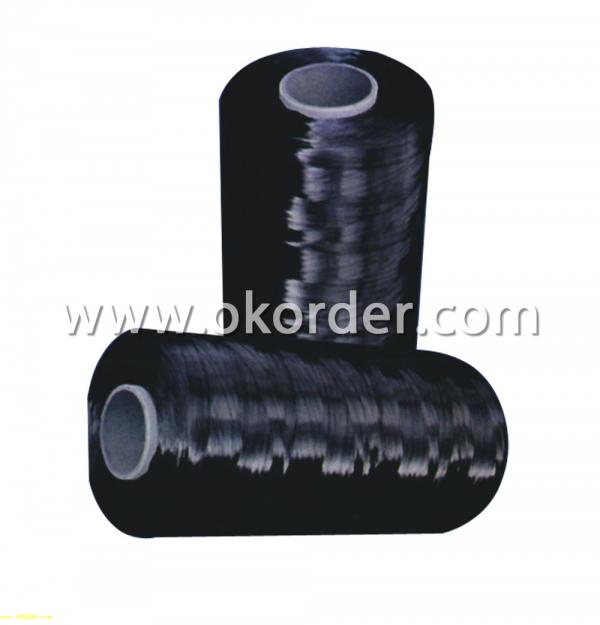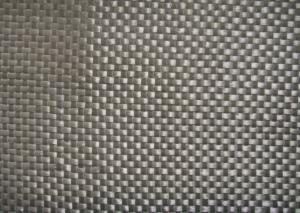Carbon Fiber T400
- Loading Port:
- China Main Port
- Payment Terms:
- TT or LC
- Min Order Qty:
- 100Kg m.t.
- Supply Capability:
- 1000Ton m.t./month
OKorder Service Pledge
OKorder Financial Service
You Might Also Like
Specifications of Carbon Fiber T400
1. Material: carbonized polyacrylonitrile fiber
2. Filament number:1k
3. Fiber type: T400
4. Tensile strength: 360kgf/mm2
General Data of Carbon Fiber T400
Weaving Style: Unidirectional, Plain, Twill
Input Available: 3k, 6k, 12k Carbon fiber
Weight: 15 0 ~ 600g / m2
Roll length: To be specified
Typical Range of Carbon Fiber T400
Remark :The above parameters are only in common condition. In case of order, the parameters are subject to the customer's confirmation.
CWP : Carbon plain weave fabric
CWT : Carbon twill weave fabric
CWU : Carbon woven unidirectional fabric
Storage of Carbon Fiber T400
It is recommended that the carbon fiber fabric are stored in a cool and dry environment. Recommended temperature range of storage is between 10 ~ 30 degree and relative humidity between 50 ~ 75%.The carbon fiber fabric should remain in the packaging until just prior to use.
Packaging & Delivery of Carbon Fiber T400
Product is manufactured in form of a roll wound on a paper tube and then packed in a plastic film and placed within a cardboard carton. Rolls can be loaded into a container directly or on pallets.
Packaging Detail: carton
Delivery Detail: within 20 days


- Q:What is carbon black dye?
- Carbon black dye is a pigment derived from the incomplete combustion of hydrocarbons, commonly used in various industries, including the production of inks, plastics, rubber, and coatings.
- Q:What are the different types of carbon-based concrete additives?
- There are several different types of carbon-based concrete additives, including carbon fibers, carbon nanotubes, and graphene.
- Q:How is carbon dating used to determine the age of fossils?
- Carbon dating is a scientific method that scientists use to figure out how old fossils and other organic materials are. It works because there is a special type of carbon called carbon-14 that is in the air and gets absorbed by living things when they're alive. When an organism dies, it stops taking in carbon-14 and the amount of it starts to go down over time as it breaks down. To find out the age of a fossil using carbon dating, scientists first take a small piece of the fossil. They then treat this piece with chemicals to get rid of any impurities and get the carbon out of the organic material. The carbon that is extracted is then turned into carbon dioxide gas, which is used to make graphite targets for measuring the levels of carbon-14. Scientists use a technique called Accelerator Mass Spectrometry (AMS) to count how many carbon-14 and carbon-12 atoms are in the sample. They then use the ratio of carbon-14 to carbon-12 to figure out how old the fossil is, based on the known half-life of carbon-14, which is about 5730 years. By comparing the amount of carbon-14 left in the fossil to the amount of carbon-14 in the air when the organism died, scientists can estimate the approximate age of the fossil. This method is especially useful for dating organic materials that are up to around 50,000 years old. For older fossils, scientists usually use other methods like potassium-argon dating or uranium-lead dating.
- Q:How is carbon used in the production of carbon nanomaterials?
- Carbon is used as the raw material for the production of carbon nanomaterials. Different forms of carbon, such as graphite or carbon black, are transformed through various processes like chemical vapor deposition or arc discharge to create carbon nanotubes or graphene.
- Q:What is the carbon footprint?
- The carbon footprint refers to the total amount of greenhouse gases, particularly carbon dioxide (CO2), released into the atmosphere as a result of human activities. It is a measure of the impact individuals, organizations, or countries have on the environment in terms of contributing to climate change. This footprint includes direct emissions from burning fossil fuels for transportation, heating, and electricity, as well as indirect emissions from the production and transport of goods and services we consume. The carbon footprint is usually measured in units of carbon dioxide equivalent (CO2e) and is an important tool for evaluating and managing our environmental impact. By understanding and reducing our carbon footprint, we can mitigate climate change and work towards a more sustainable future.
- Q:What is carbon nanomembrane?
- A carbon nanomembrane (CNM) is a thin layer of carbon atoms arranged in a lattice structure, with a thickness of just one atom, making it one of the thinnest materials known. To create CNMs, a precursor material is deposited onto a substrate and then transformed into a pure carbon layer through heat or chemical processes. The unique properties of carbon nanomembranes have generated significant interest in science and technology fields. CNMs are highly impermeable to gases and liquids, making them ideal for applications like gas separation and filtration. They also possess excellent electrical conductivity, making them suitable for electronic devices and sensors. Moreover, carbon nanomembranes can be tailored with specific pore sizes and chemical functionalities, enabling their use in molecular sieving and biological applications. They have shown potential in drug delivery, water purification, and tissue engineering. Additionally, CNMs exhibit impressive mechanical strength and flexibility, providing opportunities for use in lightweight and flexible electronics. In conclusion, carbon nanomembranes offer a versatile and exciting platform for various applications. Ongoing research and development in this field aim to further explore and utilize the unique properties of CNMs to advance different industries.
- Q:How does carbon affect the formation of acid rain?
- The formation of acid rain is not directly influenced by carbon. Instead, it is mainly caused by the release of sulfur dioxide (SO2) and nitrogen oxides (NOx) when fossil fuels like coal and oil are burned. However, the emission of carbon dioxide (CO2) from the burning of these fuels contributes to climate change and indirectly impacts the formation of acid rain. The rise in atmospheric carbon dioxide levels leads to the trapping of heat, resulting in global warming. Consequently, this alters weather patterns and increases the frequency and intensity of extreme weather events. These alterations can affect the formation of acid rain by changing how sulfur dioxide and nitrogen oxides disperse. Furthermore, when fossil fuels are burned and release carbon dioxide, they also release sulfur dioxide and nitrogen oxides as byproducts. When these gases react with water, oxygen, and other chemicals in the atmosphere, they can be converted into sulfuric acid and nitric acid respectively. The increased combustion of fossil fuels, due to higher carbon dioxide emissions, can lead to a greater release of sulfur dioxide and nitrogen oxides into the atmosphere, exacerbating the formation of acid rain. Therefore, while carbon dioxide itself does not directly contribute to acid rain formation, its emissions indirectly contribute by amplifying the release and dispersion of sulfur dioxide and nitrogen oxides. To mitigate the formation of acid rain and its adverse effects on the environment and human health, it is crucial to reduce carbon dioxide emissions, as well as sulfur dioxide and nitrogen oxide emissions.
- Q:Organic matter is converted from organic carbon. Why is humus represented by carbon instead of converted?
- Soil organic matter refers to all organic matter in the soil, due to the size of the organic matter content of different soil in a composition is more complex, but are not necessarily organic carbon containing material, so there is a mathematical relationship between soil organic matter and organic carbon. In general, we are the first to measure the content of soil organic carbon, and then use the formula to convert the content of organic matter.
- Q:Will long-term use of carbon alloy chopsticks cause cancer?
- Do chopsticks also cause cancer? Experts say, should not use too long, 3 to 6 months that change, pay attention to chopsticks material selection, use and maintenance. Have you noticed how often the chopsticks are changed at home? Recently, a news about the need for regular replacement of chopsticks, attracted the attention of Internet users. According to reports, hidden in the small groove in the chopsticks bacteria, may cause dysentery, gastroenteritis and other diseases, it is recommended that the public, chopsticks should be replaced at regular intervals of 3~6 months. This makes many people surprised, "used so many years chopsticks, do not know!"." Yesterday morning, in the south near Xi'an Renrenle supermarket shopping public Ms. Hao said. Subsequently, a random survey of 20 members of the public, of which 4 people said that in the six months of internal moving or kitchen renovation and replaced chopsticks. While the other 16 citizens, the number of chopsticks used in the home was 1~3 years. Especially for families with old people, chopsticks are updated more slowly. "The old man can't bear to throw it. He can't help it. Every time he comes to the restaurant, the chopsticks are not enough."." Liu said the public. In this regard, yesterday, director of the Xi'an Municipal Hospital of traditional Chinese Medicine Department of Gastroenterology physician Huang Yahui said, if the wood and bamboo chopsticks used for a long time, it is easy to breed bacteria sawdust loose.
- Q:Does anyone know what the definition of carbon storage is in ecology? Thank you
- 1, store it in a certain range.2 carbon storageAbout 2. No need to explain1 of the words is "popular carbon dioxide storage".. Current storage practices are generally to collect CO2 in the atmosphere and inject gas into the ground
1. Manufacturer Overview |
|
|---|---|
| Location | Jiangsu,China |
| Year Established | 2002 |
| Annual Output Value | |
| Main Markets | Europe, America, Africa, Oceania and Japan, Korea, southeast Asia |
| Company Certifications | ISO9000 |
2. Manufacturer Certificates |
|
|---|---|
| a) Certification Name | |
| Range | |
| Reference | |
| Validity Period | |
3. Manufacturer Capability |
|
|---|---|
| a)Trade Capacity | |
| Nearest Port | |
| Export Percentage | |
| No.of Employees in Trade Department | |
| Language Spoken: | |
| b)Factory Information | |
| Factory Size: | |
| No. of Production Lines | |
| Contract Manufacturing | |
| Product Price Range | |
Send your message to us
Carbon Fiber T400
- Loading Port:
- China Main Port
- Payment Terms:
- TT or LC
- Min Order Qty:
- 100Kg m.t.
- Supply Capability:
- 1000Ton m.t./month
OKorder Service Pledge
OKorder Financial Service
Similar products
New products
Hot products
Related keywords





























